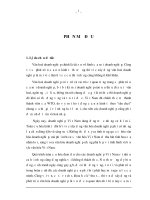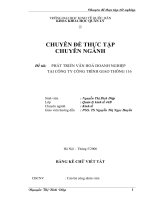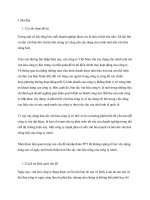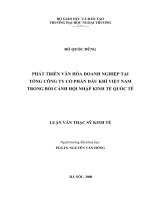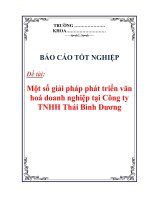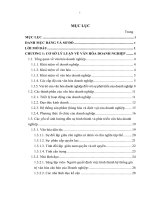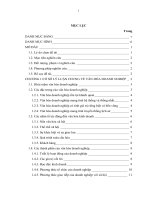Phát triển văn hóa doanh nghiệp tại thaco group
Bạn đang xem bản rút gọn của tài liệu. Xem và tải ngay bản đầy đủ của tài liệu tại đây (2.58 MB, 95 trang )
ĐẠI HỌC QUỐC GIA HÀ NỘI
KHOA QUẢN TRỊ VÀ KINH DOANH
---------------------
ĐỖ THỊ LAN ANH
DEVELOPMENT OF CORPORATE CULTURE
AT THACO GROUP
PHÁT TRIỂN VĂN HÓA DOANH NGHIỆP
TẠI THACO GROUP
LUẬN VĂN THẠC SĨ QUẢN TRỊ KINH DOANH
HÀ NỘI - 2020
ĐẠI HỌC QUỐC GIA HÀ NỘI
KHOA QUẢN TRỊ VÀ KINH DOANH
---------------------
ĐỖ THỊ LAN ANH
DEVELOPMENT OF CORPORATE CULTURE
AT THACO GROUP
PHÁT TRIỂN VĂN HÓA DOANH NGHIỆP
TẠI THACO GROUP
Chuyên ngành: Quản trị kinh doanh
Mã số: 60 34 01 02
LUẬN VĂN THẠC SĨ QUẢN TRỊ KINH DOANH
NGƯỜI HƯỚNG DẪN KHOA HỌC: PGS. TS. NGUYỄN NGỌC THẮNG
HÀ NỘI - 2020
DECLARATION
The author confirms that the research outcome in the thesis is the result of
author’s independent work during study and research period and it is not yet
published in other’s research and article.
The other’s research result and documentation (extraction, table, figure,
formula,
and other document) used in the thesis are cited properly and the
permission (if required) is given.
The author is responsible in front of the Thesis Assessment Committee,
Hanoi School of Business and Management, and the laws for above-mentioned
declaration.
Date…………………………..
i
TABLE OF CONTENTS
DECLARATION .........................................................................................................i
LIST OF TABLES ......................................................................................................v
LIST OF CHARTS AND FIGURES .........................................................................vi
BACKGROUND .........................................................................................................1
CHAPTER 1: THEORETICAL FRAMEWORK ON CORPORATE CULTURE
DEVELOPMENT .......................................................................................................5
1.1. Overview about the study on corporate culture development .............................5
1.1.1. Situation of foreign study .............................................................................5
1.1.2. Situation of domestic study...........................................................................8
1.2. General concept on corporate culture ..................................................................9
1.2.1. General concept on culture and business culture ..........................................9
1.2.2. Concept on corporate culture ......................................................................10
1.2.3. Identity of corporate culture .......................................................................11
1.2.4. Brandname ..................................................................................................12
1.3. Necessity to design and develop corporate culture ............................................13
1.3.1. For enterprise: ............................................................................................. 13
1.3.2. For the society ............................................................................................ 14
1.4. Characteristics of corporate culture ...................................................................14
1.4.1. Visual characteristics of corporate culture .................................................15
1.4.2. Non - visual characteristics of corporate culture ........................................17
1.5. Constituents of corporate culture .......................................................................19
1.5.1. Management and business philosophy .......................................................19
1.5.2. Personal and organization motives ............................................................. 19
1.5.3. Procedures and regulations .........................................................................19
1.5.4. Information exchange system .....................................................................20
1.5.5. Movement, rituals, etiquettes ......................................................................20
1.6 Benefits of corporate culture development .........................................................20
1.6.1. For enterprise .............................................................................................. 20
ii
1.6.2. For non-enterprise: ......................................................................................21
1.6.3. For branding of products and services ........................................................22
1.7 Steps of corporate culture development .............................................................. 22
CHAPTER 2: RESEARCH METHODOLOGY ......................................................24
2.1. Methodology ......................................................................................................24
2.2. Research procedure ............................................................................................ 24
2.3. Data collection sources ......................................................................................25
2.3.1. Primary data source ....................................................................................25
2.3.2. Secondary data source ................................................................................25
2.4. Data collection method and tools .......................................................................25
2.4.1. Data collection method ...............................................................................25
2.4.2. Data collection tools ...................................................................................25
2.5. Data analysis and processing method ................................................................ 27
2.5.1. Primary data processing method .................................................................27
2.5.2. Statistics and comparison methodology .....................................................28
2.5.3. Descriptive statistics methodology ............................................................. 28
2.5.4. Analysis and synthesis method ...................................................................28
CHAPTER
3:
EXISTING
STATUS
OF
CORPORATE
CULTURE
DEVELOPMENT IN THACO GROUP ...................................................................30
3.1. Overview about Truong Hai Automobile Joint Stock Company (THACO) .....30
3.1.1. History of development of Truong Hai Automobile Joint Stock Company......31
3.1.2. Organizational structure in Truong Hai Automobile Joint Stock Company
(THACO) ..............................................................................................................33
3.1.3. THACO's value chain .................................................................................35
3.1.4. Evaluate human resources characteristics in THACO ............................... 36
3.1.5. Evaluate the operation performance in the period of 2015 - 2018 .............39
3.2. Existing status of corporate culture in THACO through visual characteristics ........40
3.2.1. Available cultural values of THACO .........................................................40
“3.2.2. Corporate culture development through 8 T principles in THACO .........41
3.2.3. Corporate culture development through THACO song .............................. 42
iii
3.2.4. Cultural development through Code of Conduct in THACO .....................42
3.2.5. Corporate culture development through THACO HR evaluation culture ..43
3.2.6. Corporate culture development through THACO typical publication
magazine ...............................................................................................................47
3.2.7. Corporate culture development in other charity activities ..........................47
3.3. Existing status of corporate culture in THACO through non-visual characteristics .48
3.3.1. Corporate culture development through converting THACO culture into
action by each member .........................................................................................48
3.3.2. Corporate culture development through emphasis level in THACO .........51
3.3.3. Corporate culture development through working environment in THACO .....52
3.3.4. Corporate culture development through cultural rituals and expression in
THACO .................................................................................................................52
3.3.5. Corporate culture development through Culture - leadership style in THACO 55
3.4. Evaluation of corporate culture development in THACO group .......................56
3.4.1. Achievements.............................................................................................. 57
3.4.2. Shortcomings .............................................................................................. 57
CHAPTER 4: SOLUTIONS FOR CORPORATE CULTURE DEVELOPMENT IN
THACO .....................................................................................................................60
4.1. ThACO’s development and operation orientation to 2020 ................................ 60
4.2. Corporate culture development solution in THACO .........................................64
4.2.1. Improve working capacity of the Culture - Communications Board .........64
4.2.2. Improve and raise the awareness on corporate culture for the employees .66
4.2.3. Perfect the annual HR evaluation procedure ..............................................67
4.2.4. Design the behavior culture manual, governance regulation and rule system
in THACO.............................................................................................................69
4.2.5. Design and develop THACO brand ............................................................ 69
4.2.6. Set up corporate culture development procedure in THACO ....................70
4.3. Some recommendations .....................................................................................70
CONCLUSIONS ................................................................................................ 74
APPENDIX
iv
LIST OF TABLES
Table 1.1. Characteristics of corporate culture .........................................................14
Table 2.1: Summary of questionnaire structure for official study ............................ 27
Table 3.1: Statistics of THACO employee gender and age updated on October 2018 ....36
Table 3.2: Statistics of THACO employee qualification, updated on October 2018.......37
Table 3.3: Some business performance in the period of 2015 – 2018 ......................39
Table 3.4: HR evaluation table in THACO............................................................... 43
Table 3.5: Applicable standard criteria table of THACO .........................................44
Table 3.6: General evaluation on corporate culture of THACO members ...............50
Table 3.7: Survey table on members’ awareness on corporate culture .....................53
Table 3.8: Influence of leadership style on THACO members ................................ 55
v
LIST OF CHARTS AND FIGURES
Figure 3.1. THACO market share revenue in 2018 ..................................................32
Figure 3.2: Standard logo of THACO .......................................................................36
Figure 3.3: Evaluation of labor age percent in THACO updated on October 2018 ........37
Figure 3.4: Available qualification of THACO staff, updated on October 2018 .....38
Figure 3.5: HR evaluation procedure in THACO .....................................................44
Figure 3.6: Sequence of approving the annual HR evaluation results ......................46
Figure 4.1: THACO's operation and development orientation to 2020 ....................60
Figure 4.2: THACO development mission to 2020 ..................................................62
vi
BACKGROUND
1. Necessity of the study
With response to the international and regional economic integration
development trends, Vietnamese enterprises and organizations are put under
increasingly high pressure not only from the foreign counter-partners but also cutthroat competition even in each agency and organization. The Vietnamese and
international practice proved that a positive cultural environment is a reliable
background to successfully compete and create the sustainable development for the
organization and enterprise. However, in such globalization trend, the cultural
assimilation is tended to increase. In order to prevent from becoming a cultural
consistency, each organization is required to maintain and uphold its own culture.
Culture decides the survival of an organization and helps it further develops out
of the starting point of founders. Culture is also recorded as an intangible asset of
such organization. Culture helps the organization to reduce the conflict, coordinate
and control, motivate the employees and enhance the competitive advantages. By
reducing the conflict, culture cements the organization’s members who may be
unified in terms of understanding, evaluation, and selection and action orientation.
When the organization is faced with conflict tends, members are unified by the
culture. When a complicated decision is required, culture helps the organization to
narrow down the options to be considered, motivate the employees so that they may
master their job objectives and orientation, creating the good relationship between
the employees and a convenient and healthy working environment.
Organization culture plays an important role not only for improvement of
comprehensive work performance but also an important solution to successfully
improve the competitiveness. Culture creates the differences and distinguishes
among organizations.
Corporate culture may be regarded as one of valuable intangible asset of each
enterprise. Corporate culture may create trust for each person working in such
environment, a link among the members of the enterprise, creating the voice
between the members and improving the enterprise’s competitiveness. Therefore,
1
corporate culture may be regarded as an important mechanism in managing human
resources. Meanwhile corporate culture is really merged into the objectives of each
member, then, they may consider the enterprise’s objectives as their personal
objectives. That is why culture-based management may drive the enterprise’s longterm development.
To become the universal industrial Group and Vietnamese Brandname to be
recognized as the regional leading position in ASEAN, THACO is required to make
ceaseless efforts to develop its internal force, renovate the thinking and action, and
improve the quality and scale of the staff. In order to do these, one of important
tools to manage and govern the Company is THACO culture.
By always submerging the idea that the staff is the important resources to create
the success and sustainable development, THACO culture is oriented toward
developing a qualified staff with strong will, positive working attitude, high
creativeness and high sense of qualification improvement to be able to work in a
discipline and contribute to the Company's development. As a result, they become
the person useful for the society and the Country.
With awareness of significance of corporate culture on enterprise’s success and
the sustainable future of the Group, creating a reliable premise to extend to the
region and the world, “Development of corporate culture in Thaco Group”
(THACO) topic is selected as the author’s graduation thesis.
2. Objectives
The thesis's research objectives include systematizing some basic theoretical
issues on corporate culture and development of corporate culture; evaluating the
results of developing Thaco Group to be cemented with the Group's development
and growth, proposing some possible solutions to successfully develop Thaco
Group's corporate culture.
By analyzing and comparing the theories with the practice by constituents of
organization culture; Analyzing the concerned concepts, phenomenon of objective
and non-objective corporate culture; viewpoints and development of corporate
culture; evaluating the existing conditions of maintaining and developing the
2
corporate culture at Thaco Group, awareness of achievements and obtained values;
Analyzing the shortcomings and its root causes; Analyzing the available
characteristics of the unit; accordingly, suggesting the development orientations for
the corporate culture, giving out the proper development method and progress,
convincing and feasible solutions and recommendations on corporate culture
development for the local unit
3. Subjects of research
Subjects of the research are the corporate culture, including: Factors affecting
the corporate culture, characteristics and forms of corporate culture, levels of
corporate culture. The respondents include officials and employees of THACO
4. Scope of research:
4.1 Scope of space:
Thaco Group’s branches extend nationwide, including 3 Branches, namely: The
North, the Central and the South, general office in Ho Chi Minh City and Hanoi
office. Questionnaire is launched in Showrooms, branches and subsidiaries of
Thaco Group.
4.2 Scope of time:
The scope of space is launched at Thaco Group.
Regarding the scope of time, secondary data collected from key period of 2013
- 2018 is used herein. The secondary data is used to forecast Thaco Group’s
development up to 2022. Primary data was collected in 2018 via questionnaires.
The solutions on perfecting the corporate culture to 2022 are proposed by the study.
5. Research methodology
A series of methodologies are applied by the thesis:
Statistics methodology: Thaco Group’s data summary is related to corporate
culture development.
Analytic method: The reports on Thaco Group's culture development and
implemented solutions are analyzed.
Method of listing, comparing and evaluating the sociology survey method:
Questionnaire uses 3 question types, including closed questions (Yes or No, not go
3
in-depth into the feelings of the respondent as predetermined below that the
respondent only marks the questions that he/she agrees), opening questions (the
question enables the respondent to specify his specific viewpoints into the
questionnaire) and combined questions.
Number of questionnaires: 300
Respondents: Leaders, official and employees of Thaco Group. Respondents
shall be collected, selected and named in the list (300 respondents) before official
launch is initiated. Secondary data is collected from the previous studies. Data
collection is initiated within Thaco Group by accessing and collecting the 5-recentyear data and information from Thaco Group's Board of Culture Communications
and Board of Planning and Finance.
Data processing and analysis method: statistics methodology, analytic method,
comparison methodology are applied to clarify the theories. The theoretical review
is combined with the general practice to clarify the basic contents hereof. Moreover,
the thesis is also inherited and developed from the related studies’ findings to clarify
the main topics of the thesis.
4
CHAPTER 1: THEORETICAL FRAMEWORK ON CORPORATE
CULTURE DEVELOPMENT
1.1. Overview about the study on corporate culture development
Corporate culture or company culture has been widely studied and announced in
the world and in Vietnam by many researchers. Approaches to the corporate culture
are varied by each researcher.
1.1.1. Situation of foreign study
Corporate culture in the world is generally characterized by 2 different research
orientations. The first orientation is to approach under the perspective of ongoing
business administrators (micro-approach), focusing on searching and looking for the
management nature of the cultural factors in business administration. The second
one is to approach from the perspective of the cultural factors’ impact on business
administration (macro approach), focusing on the cultural factors’ impact on
businesses, especially for businesses with a multicultural or organizational
environment
a. Three-tier corporate culture model of Schein
Three-criteria-based evaluation method of corporate culture is applied by
Schein's research model, concretely: Tangible structure, announced value and
general concepts, implications. The evaluation method of corporate culture is
considered to be more practical than the theoretical value of that of the competitive
value framework. That is the three-tier corporate culture model (Schien 1999).
Schein’s model is focused on three levels of culture that are the three evaluation
criteria of culture, from practice, implications to invisibility:
-
Level 1 (Practice): Provide specific evidence such as folk stories, protocols, stories
and symbols.
-
Level 2 (Standard value): Explain the strategy, purpose and philosophy to guide the
thinking and behavior in the enterprise.
5
-
Level 3 (General implication assumption): Including the basic assumptions,
awareness, value, trust and especially from the founder or the leaders of the
Company.
Advantages: Evaluation method under E. Schein model is relatively simple and
easy to perform, suitable with the enterprise with restricted time and budget for
understanding its own culture. By using this model, the leader is facilitated to
effectively identify, in particular, the cultural elements of the business, and analyze
the relationships between tangible and cultural values which are deeply originated
from the business initiated by the company. Similarly, the leaders find the cultural
elements to be changed to be well matched with the Company’s ever-changing
environment in accordance with new competitive conditions and new regulations.
b. Studies launched by Recardo and Jolly
Recardo and Jolly (Recardo & Jolly, 1997) unveiled that, when the corporate
culture is mentioned, it often covers the system of values and beliefs that are
understood and shared by members of an organization. A culture helps to shape and
define members' behaviors and organizational policies. Corporate culture is
measured by 8 aspects, concretely:
- Communication: Quantity and forms of communication, what information is
communicated and by which way, open communicative system must be provided.
- Training and development: The administrators’ commitment to offer the
great development and organizational opportunities that new skills are enabled to be
applied for the practice. Moreover, training programs are provided to successfully
satisfy the employee's current or future development needs.
- Bonus and recognition: The rewarded behaviors and the applicable bonuses,
employees to be rewarded individually or collectively, promotion criteria, and the
degree to which the organization provides feedback on the job satisfaction level.
- Decision making: Decision making is related to the questions such as how
the decision is made and how the conflicts are handled. Decisions are quick or slow.
The organization is high ranking. Decision making is characterized by concentrating
or decentralizing.
6
- Risk acceptance: Creativeness and renovation are highly appreciated and
rewarded. Risk acceptance is encouraged and welcome with the new ideas.
Employees are punished or motivated to test the new ideas.
- Plan orientation: Planning is short term or long term, and future planning is
applied, which visions, strategies and objectives are shared with the employees. To
which extent, the employees make commitment to fulfill the enterprise’s strategy
and other organization objectives.
- Group work: This aspect relates to the issues, including significance, form
and effectiveness of group work in the organization. It includes the significance of
cooperation among various departments, trust between the functions or units, and
mutual support for work performance.
- Governance policies: This aspect measures fairness and consistency with the
implemented policies, the impact of member governance styles and the governance
level that provides a safe work environment.
c. The Denison model (1990)
The Denison model is based on 200 years of research on how corporate
culture affects the performance of businesses. Denison's research has found a link
between the organizational culture evaluation score and the key performance results
of the business such as profitability (ROE, ROA, ROI), growth (sales growth rate). ,
market share), quality, innovation, employee and customer satisfaction.
This model aims to analyze and evaluate the constituent factors and influence
on corporate culture including 4 main feature frames, each characteristic frame is
assessed through 3 scales, each scale consists of 5 similar variables. corresponding
to 60 questions in the Denison questionnaire.
Based on the model, we can see the correlation between the cultural factors
of the model and important data about the organization's activities. For example, a
high score in a Stable region tends to show the strongest relationship with
profitability, while a Flexible area has a strong relationship with performance such
as innovation and customer satisfaction ... Hay cultural factors that exhibit
Outward-Focusing tend to have strong relationships with the overall development of
7
the organization while factors related to Introverted are related to performance
measures such as performance, quality and employee satisfaction.
1.1.2. Situation of domestic study
a. According to the study released by Asso.Prof.Dr. Do Minh Cuong
Presented in the course books “Business culture and philosophy” of the
National Political Publishing House, published in 2001, the definition on corporate
culture is released by focusing on in-depth research of business philosophy issues.
(Do Minh Cuong, 2011)
b. According to the study of Nguyen Anh Tuan, M.A and Nguyen Phuong Mai, M.A
Research objectives and contents: Analyze the mutual interaction between the
enterprise's cultural environment and the selection and implementation of strategies
initiated by Vietnamese enterprises in the ever-changing economic period. Offer the
possible recommendations for Vietnamese enterprises to successfully develop a
corporate culture in accordance with the strategic orientation and good match with
the changing environments. Main findings: Specify the impact of economic and
social characteristics in the transition period to the issue of awareness and how to
develop the corporate culture and business strategy. Determine the existing
conditions of corporate culture that is compatible with the strategy of Vietnamese
corporate culture. Put forward some recommendations and set up the corporate
culture that is compatible with the business strategy. Training results of the study:
References for Strategy Management and Corporate Culture. (Nguyen Anh Tuan
and Nguyen Phuong Mai, 2011).
c. According to the study of Nguyen Viet Loc, M.A
Entrepreneurship is recognized as the core values categorized as the qualities,
capabilities and moral qualities that must be obtained and pursued by the
entrepreneurs. By inheriting the studies on entrepreneurship and entrepreneurship
culture, a cultural value system of Vietnamese entrepreneurs has been designed and
developed in accordance with the core factors of entrepreneurship, including: Great
business aspiration; Capacity to search, create, master business opportunities;
8
Independence, determination, confidence; Dare to do, dare to take responsibility;
Flexibility, activeness; Always application of new ideas, methods and solutions to
solve new problems; Business ethics and corporate social responsibility. It is also
given out hereof to measure and simulate such factors to facilitate the evaluation and
orientation of Vietnamese enterprises’ cultural values in the context of international
economic integration nowadays. (Nguyen Viet Loc, 2011)
1.2. General concept on corporate culture
1.2.1. General concept on culture and business culture
The history of development has proved that culture is the most important factor
to distinguish the nations, regions or groups of persons, including individuals, etc.
"Culture affirms the development, demonstrates the power of society and the people
it represents.” Rabin Dranath Tagore, the Indian famous writer (1861-1941) affirms
that: “responsibilities of each nation are to clearly show the world its unique
identity. He thought that if a people does not bring anything to the world, it shall be
so bad, it shall be worse than perdition and not be forgiven by the history”. “”
Terms “culture” is originated from Latin language, i.e., “Cultus” refers to
cultivation, care of trees. Then, “cultus” is extended to the social fields, implicated
for spiritual care, education and human training towards a better orientation.
To the widest scope of research: “Culture is the master of spiritual and physical
values created by the persons during survival and development”. “Physical values
may refer to: beauty spots, pagodas, temples, historical relics as well as the
traditional cultural products. For example, Vietnam is recorded with: Bat Trang
ceramic village, Dong Ho picture or historical relics such as: Hoang Thanh Thang
Long, Temple of Literature. The spiritual values are demonstrated in the living
habits, folk songs, “hat xam”, adoration, and especially Vietnamese Xoan singing
recognized by UNESCO as an intangible cultural heritage representing the
humanity.”
To the narrower scope of research: “Culture refers to the activities and spiritual
value of the human beings”. To this extent, Scientific culture such as mathematics,
physics, chemistry, culture and concerned industries, etc., and art culture such as
9
movies, literature, music, etc., to be considered as two main subsystems of the cultural
system.
When Culture is referred, it surely covers the very famous brief and cohesive
definitions of the famous French politician Édouard Herriot (1872 – 1957), that is
“Culture is the remaining when everything is forgotten, the insufficiency when we
have learn everything”. Therefore, culture is the identity of every individual, every
nation, every nation which cannot be easily forgotten. However, this definition only
shows the importance and extent of the culture, rather than the specific
characteristics.”
Another famous cultural researcher, Federic Mayor, UNESCO's Chief
Executive Officer (1987 -1999), gave out a specific definition, concretely: "Culture
reflects and demonstrates generally and vividly all aspects of life (of each
individual and community) that took place in the past as well as happen in the
present, over the centuries. It constitutes a system of traditional values, aesthetics
and lifestyle which each ethnic group asserts its own identity.” Through the
aforesaid investigations, a concept on culture may be drawn out as follows:
“Culture refers to all spiritual and physical values created by the human beings
during survival and development”.
“1990s witnessed the appearance of term of business culture and corporate
culture. Business culture appeared before the corporate culture. Such two concepts
are simultaneously used and mutually supported to each other.”
Therefore, corporate culture is the expression of business culture at corporate
level. hence, it is concluded that corporate culture is a phenomenon and part of the
business culture.
1.2.2. Concept on corporate culture
Each organization is supported by certain standards of moral values, typical
images, anecdotes, idiosyncrasies and typical styles that are recognized,
implemented, complied and communicated by all members by time. It is acted as
the reliable basis for the organization members to follow and create the important
influence on routine behaviors of every member.
10
Corporate culture is construed as: “a system of meanings, values, key trusts,
awareness and thinking method to be agreed by the organization members, widely
affecting the member’s action manners”.
The question is that: What is corporate culture? Corporate culture is
characterized by various definitions and understandings. The scholar Georges de
Saite Marie – a French expert on SMEs defined that: “Corporate culture refers to
collection of values, symbols, legend, protocols, prohibitions, physiology and moral
viewpoints to create the reliable background of the enterprise”. It is possible to see
that the concept only summaries the constituents of corporate culture, rather than
mutual relation inside the enterprise.
A relatively popular definition on “Corporate Culture” of the scholar Edgar H.
Schein, an US expert, recorded with many years in studying the culture is shown as
follows: “Corporate culture is the collection of rules and procedures acquired by
the enterprise members during problem solving, adapted from outside and
internally consisted in the enterprise.” “Such rules and procedures are the triggers
for the members to select the action method, analyze and make proper decisions
without hesitating about the meanings of such rules and procedures. It is considered
to be correct from the beginning.”
In short, even it is defined differently from time to time, it is possible to reach
an agreement on corporate culture definition, concretely: “Corporate culture refers
to a system of value, concepts and behavior rules to be internally shared by the
enterprise, governing the feeling, thinking and how to act of members during
pursuing and fulfilling the general objectives, creating an unique identity of each
enterprise.”
1.2.3. Identity of corporate culture
Identity is characterized by corporate culture philosophy, unique phenomenon
of style, action, behavior of organization, reflecting the selected values and
philosophy. Organization's cultural identify is clearly demonstrated by organization
members’ behavior. It is also the sign to show the consistency in terms of
awareness, key philosophy values of the company.”
11
“Corporate culture identity is not long-lasting; it may be varied by following
characteristics:
“Cultural identity may be created: Persons who may create the cultural
values and identities are founders. Since its inception, the organization’s missions
and individual's cultural identity values are specified.
“Cultural identity may be formed by strengthening: In such cases, leaders
find the way to protect and preserve the prevailing moral and cultural values. They
may be very successful outstanding characters in some fields, or they may
undertake the position and responsibilities for preserving and enhancing the created
cultural identity. Therefore, operating philosophy culture is deeply submerged in the
consistent culture.
“Cultural identity may be formed by integration: Leaders often apply the
leading and integrating style, attentively listen and find the best way to successfully
integrate, act as a bridge to connect, regulate, motivate and share with other persons.
Thence, leadership philosophy and style are deeply characterized by integration culture.”
“Cultural identity may be changed: Changes in culture may be required
when the fundamental changes are recorded in the organization such as
industrialization or technology, foreign culture integration (cross-culture), changes
in senior managers. Pressure of such changes requires to take the great and
fundamental changes in terms of leadership style, philosophy and action guidelines.
When the culture is changed, leadership philosophy and style are deeply
characterized by adapt culture.”
1.2.4. Brandname
Brandname is a very popular concept widely concerned since long time. This
concept is also interpreted by various manners such as: “Brandname is the dignity
of the organization and enterprise and known as a well-respected principles, values
and action philosophy of such organization and enterprise which are easily
recognized or looked back through the corporate culture’s phenomenon”.
12
Brandname “is a collection of customer’s feelings on a company, a product or
service in all material aspects: Description of identification, values, properties and
identities. Brandname binds the consumers through brandname -consumer relation.
In terms of identification, Brandname is a name or signal to identify a product.
A successful brandname is the milestone for a product with sustainable competitive
advantages. BMW, Coca Cola, etc., are the typical examples on corporate
brandname, while Louis Vuiton, GUCCI, Dove, etc., are typical examples of
product brandname. Hence, it is possible to understand that: “Brandname is a nonphysical component but essential to an enterprise. Once the products are qualified
with the levels that are almost indistinguishable by nature, characteristics and
benefits, brandname is the only factor that makes the difference between the
products and the brands, demonstrating the great trust and safety. ”
1.3. Necessity to design and develop corporate culture
1.3.1. For enterprise:
Corporate culture is characterized by the business identities to distinguish them
from other businesses.
Since its inception, the enterprise may not have a stable and specific identifiable
culture. “Through a long history of development, from ups and downs, through the
competition and construction, cultural factors shall be formed, selected and
developed as a system, creating a specific business guideline of such enterprise,
distinguishing it against other enterprises and social organizations.”
Such style for the enterprise is as important as “water and air” for the people. It is
easy to realize a style of a successful enterprise. Such style is often foot printed with an
extremely strong impression to the outsiders and great pride of the enterprise members.
Corporate culture creates the behavior patterns, widely accepted and complied
by the members, demonstrating the good harmony within the business in general, as
well as making decisions in specific cases. Such patterns are general standards and
values to commend the good behaviors and criticize the bad behaviors, thence, the
persons may know what should to do and what should not to do.
13
Corporate culture enhances the work motivation, facilitating the loyalty,
engagement, creativeness and devotion of the staff.
1.3.2. For the society
Entrepreneurs in particular and interested persons concerning the economic
growth in general acknowledge the special role of corporate culture in economy
development. Culture itself is always implicitly submerged with humanism values;
therefore, corporate culture always requires businesses to closely cement to business
efficiency with humanity in business: Efficiency cannot be obtained at any cost that
humanism values are ignored. Simultaneously, production and business activities of
each enterprise are oriented towards improvement of the community, ethnicity
spirit, and businesses are encouraged to join the social activities such as poverty
reduction, relief for natural disaster victims, charitable activities, etc.. If cultural
elements are unavailable, the society will have to bear the extremely serious
consequences, especially exhaustion of natural resources, discharge problems, and
environmental pollution caused by production.
1.4. Characteristics of corporate culture
Corporate culture is demonstrated through typical signs, phenomenon and
characteristics. Characteristics refer to anything which may be used to demonstrate
the contents of corporate culture, key philosophy, value and trusts, how to aware
and critical thinking to help the members during their awareness to correctly reflect
the awareness of the members and entire organizations.
Characteristics are used to represent the contents of corporate culture, so-called
as visual symbols. Such symbols facilitate the easy seeing and hearing. Non-visual
characteristics are specific signs to be demonstrated in the members’ awareness
level on corporate culture.
Table 1.1. Characteristics of corporate culture
VISUAL CHARACTERISTICS
NON-VISUAL
CHARACTERISTICS
-
Interior and exterior architecture
- History of development and tradition
14
-
Logo, slogan
of the enterprise
-
Typical publication
- Vision, mission and core values
-
Anecdotes
- Trust value and attitude
-
Rituals, meetings
- Business philosophy
-
Costumes
- Personal and organization motives
-
Behaviors and communication
Source: Collection by the author in the 2018 study
1.4.1. Visual characteristics of corporate culture
a. Architecture characteristics
Particular architecture includes office’s exterior and interior architecture used as
the company’s logo and images to create the familiar and good will impression of
the Company.
Architecture design is widely interested by the organizations because:
- Exterior architecture may significantly affect the human behaviors in terms of
how to communicate, react and perform the works. For example: church
architecture gives a strong, powerful impression; The pagoda creates an impression
of transparency and continuity; The library impresses highly and intellectually.
- Architectural works may be considered as a “mascot” denoting a certain
meaning or value of an organization or society. For example, France's Eiffel Tower,
China's Great Wall, Temple of Literature, One Pillar Pagoda, etc., has become an
image and symbol of a national and local spiritual value.
- Structural design may be regarded as a symbol of the organization's strategic motto.
- Architectural works become an organic part of the company's products.
- Each architecture is submerged with historical values associated with the
availability and growth of the organization.
b. Rituals, etiquettes
One of characteristics of corporate culture is rituals and etiquettes. These are
carefully planned and prepared activities in the form of activities, official sociocultural events, serious and emotional activities that are carried out periodically or
15
irregularly to tighten the organizational relations and often held for the benefit of
attendees.
The characteristics of the ritual’s form and content not only show the values and
philosophy of the corporate culture that the organization wants to emphasize, but
also specific views and approaches of the managers.
c. Symbol, logo
Another tool of corporate culture characteristics is the symbol. The architectural
works, rituals, anecdotes and logo contain the logo’s characteristics through
physical and tangible values. Such characteristics aims to convey a potential value
and meaning to the receiver in various manners. The most important thing of
branding is to select the name, logo, package design and various attributes to
identify a product and distinguish it with others.
Another symbol is the logo or creative masterpiece to be designed to
demonstrate the image of an organization or a business in the popular artistic
language. Although logo is a very simple demonstration, it is assigned with a great
significance. Hence, it is remarkably focused by organizations and businesses.
Nowadays, logos of the world's leading brands such as Coca-Cola, Microsoft,
Toyota, etc., have been received with the worldwide special attention and influence.
A brand's logo must be developed with specific cultural meaning and
submerged with the culture identity. Brand logo must be well matched with the
various culture or languages.
d. Short stories, anecdotes, typical samples
Short stories are stories which are often developed from typical events in terms
of values and philosophy of corporate culture reminded and disseminated to new
members by the organization. In the stories, the typical samples are often
mentioned. They are ideal pattern in terms of behavior suitable with the standards
and corporate culture values. Typical samples may be personified into myths with
the qualities and characteristics of many good examples or expectations of values
and beliefs in the organization. Stories aim to maintain the vitality of the
organization's original values and help to unify the awareness of all members.
16
Model characters embody the values and lasting power of the business. These
are the enterprise’s core figures, facilitating to create a distinctive image of the
business, making the outstanding results simpler, promoting many classes of
employees to follow, strengthen and promote the cultural environment in the
enterprise.
e. Language, slogan
Special sayings, slogan, metaphors or a nuance of words are used to convey a
specific meaning to the employees.
Slogans are easy to memorize and cited not only by employees but also by
customers and many others. Slogans are often very brief, or characterized by
simple, easy-to-remember words, so it sometimes seems to be cliché in terms of
form. The slogan is recorded as the most succinct expression of an organization's or
a company's business and operational philosophy. Therefore, it must be closely
linked with the mission statement of the organization or company to thoroughly
understand their implicit meaning. For example the slogan of Vietjet Airway:
“Enjoy Flying”; Heineken: “It could only be Heineken”; Trung Nguyen Coffee:
“Explore creative inspiration”.
f. Typical publication
Typical publications are the official data which may help the stakeholders to
thoroughly understand the cultural structure of an organization. It may be the
mission statement, annual report, advertisement booklet, brochure about the
organization, company, traditional yellow book, periodic or special publications,
advertisement documents on products and company, user’s manual, warranty
instructions, etc.
Strength of corporate culture is characterized by consent of organization
members regarding the significance of specific values. In case of consent, corporate
culture cements the members and generates the powerful strength to develop a
strong culture for the organization.
1.4.2. Non - visual characteristics of corporate culture
a. Ideal/mission
17

